If you’ve read a marketing article or two, you’ve probably heard about the unique selling proposition (USP). I bet a lot of marketers could say it was one of the first marketing concepts they learned. That was definitely the case for me. But what does this very popular acronym mean, and why would any business owner care?
Don’t worry, our friends, that’s why this article came to life. Today we’re going to talk about how to write a unique selling proposition, and we’re going to present to you some unique selling proposition examples.
1. What is a Unique Selling Proposition?
Let’s start out with a good old-fashioned definition.
USP stands for unique selling proposition (also known as a unique selling point), which is defined as a one-of-a-kind benefit that a company offers to the customer. This is the main selling point you have, the reason why the consumer will choose you and not the competition. It’s pretty much mandatory to be aware of your USP as a business, especially when you’re just getting started.
2. Why do you need a Unique Selling Proposition for your business?
- Differentiation in business drives sales. In a world where people are bombarded every second by a Facebook ad or a Google ad, your brand has to stand out in front of your potential consumers as the right choice. If you’re just like every other business out there, then you’re just relying on the hope that consumers will find you first. And nowadays, it’s not just about ad performance; it’s about providing value to your customers by solving their needs. Success stories come by offering an exquisite customer experience, and the only way to do that is by having a great market fit – offering your service to people that really need it. A strong value proposition helps you find the ideal customers for your product/service.
- You will get brand awareness. A unique selling proposition might be implied. Some people might know why you’re unique, but most of them don’t. So why wouldn’t you just tell them? If you tell them you’re the “go-to place” for insert main selling point, then you have already positioned yourself in their mind. You might have the world’s strongest service; if you’re not talking about it nobody will know.
- You’ll have a better elevator pitch. You might be a sales professional, but especially in the beginning, it’s easy to lose confidence when a potential customer is doubting you. But when you know exactly how you are different from your competition and how you can create a better customer experience, then the sales pitch just comes naturally.
- You will reach the right audience. In 2021 customers choose businesses that resonate with them. It’s about values, not only about the product. If you say loud and clear that you’re the best option for something, and you show it, be it an ecommerce business, a product business, or a service one, then customers that look for that benefit will contact you. The ones that don’t will not. And, trust us, that’s a win-win situation. Neither you nor they want to lose time and money trying to make it work. Sometimes, customers are just not right for your business. And that’s totally okay.
- Your clients will trust you. If you make a promise to your clients and you keep it, then you are creating the image of a trustworthy company. In time, this will not only create loyal customers but actual promoters for your brand. This is the ultimate goal of differentiated marketing. Your clients will become evangelists by sharing customer stories and the benefits of working with you.
3. Unique Selling Proposition examples
Before starting to work on your unique selling proposition, let’s go through some examples to inspire us. Some of them are killer USPs; others are just nice to know.
- M&M: Enjoy chocolate without it melting in your hands.
- Domino’s Pizza: Satisfy your hunger by delivering it in 30 minutes or less.
- Digitalya: Create a top-quality software product by using the “Less is more” methodology.
- Toms shoes: For every pair of shoes a customer purchases, the company donates a pair to a child in need.
- Saddleback leather: They’ll fight over it when you’re dead.
- Dollar shave club: Shave time. Shave money.
- Warby Parker: Customers buy one pair of glasses and donate a second one to someone in need.
4. How to write a Unique Selling Proposition
Now that you know the importance of creating a USP, let’s actually start the process of writing a unique selling proposition. To get an idea of what we’re going to talk about, below you can see the USP canvas we have created.

And if you already want to download it, you can do so here.
Throughout the article, we’ll also present an example of using the canvas for a fictive company selling email automation software. Let’s get right into explaining each section.
a. Identify the problem that your business is solving
Of course, we’re starting from the client! After all, that’s who you’re writing the USP statement for. Think about the problem that your product/service solves and just write it down.
If you’re a bit stumped here, then you can go to our Buyer Persona article, where we have a more in-depth explanation of how to figure out your customer’s needs, problems, wants & expectations.
Did you write the problem down? Good. Let’s go right to the second question you have to answer.
b. Define the solution that your business is bringing
Obviously, we’re talking here about how you can solve the problem you just wrote down.
For instance, if your client’s problem is that they’re hungry, there are about a billion products that could solve this problem. What’s your solution?
Example:
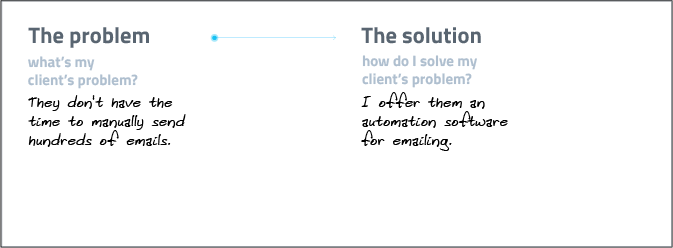
c. Analyze your competitors
Now, you should do some competitor analysis to see other strong USPs because, after all, you cannot know whether you’re unique if you don’t know what your competitors are known for. That makes sense, right?
Here we suggest you include your three main competitors (or more) and the unique value proposition they are known for: either for product features like materials and design or other business-related elements like customer support, qualified personnel, and so on.
If you don’t already know what they are known for, you could try to look at their website and see if there’s a benefit they seem to promote more than anything else. Or, you could look at their reviews online (on social media, on search engine results, on review-specific websites like Yelp) and find out what their customers praise them for the most.
d. What are the common practices in my industry?
You’ve seen what your main competitors are known for, so you can move on to establishing what the common practices in your industry are.
Common practices could mean a lot of things: product features, customer service standards, employee skills, etc. That’s quite a vague definition, we know.
You should just think about your industry and what you can associate with it. These details should be universally accepted both by businesses and clients. If there’s nothing popping into your mind instantly, then you should maybe check some competitor websites and make a list of the features they all mention.
For instance, in the software world, it’s a common requirement for web applications to be scalable and based on the latest coding standards. Everyone knows that. The majority of web development companies take these requirements into account. Only after having these two aspects nailed down can they go on and think about what unique feature to offer clients.
Example:

Do you have a few items written on your list as well? Awesome. Let’s carry on.
e. Write down your uniqueness
Finally! We’re talking about you! By now, you have a list of the unique features of your competitors and the common practices in your industry.
So… why do you even have this list? Well, you should try not to use any of these items as your USP.
What!? We know, we know. Hear us out.
Firstly, you have your competition’s unique selling propositions. They’re obviously good at those things. That’s why they parade it all over town. Now, of course, you could go after their key selling points.
But the truth is that your competitors are not your enemies. You shouldn’t go to war on their own turf, but rather, find something new and refreshing to offer clients.
Secondly, we have common practices. It’s pretty much self-explanatory why you shouldn’t use these. Everyone is doing them. Without a doubt, you should include them in your marketing strategy – without them, the client won’t even give you the time of day.
But you shouldn’t put all your money into common practices. They’re just not exciting. It doesn’t make the customer go: “Woah!” because they’ve already seen it in a dozen other places.
So… cross all of those elements out. What are you left with? How are you different from your competition? Give yourself a little time to really think about it, write it down, and then move on to the next step.
f. Define the features you want to be known for
Now the tricky part begins. Which selling point do you choose?
Well, you could start by sorting them out. There might be a few items on that list that, while they are unique, they are not as significant as the others. Not to you and not to your customer.
For instance, let’s say we have a coffee shop. And in our coffee shop, all the baristas wear cool green caps, something that no other coffee shop in our town has. While that’s unique, it doesn’t pose much importance to our customers, so it’s not a feature that we want to make our main selling point.
However, if we’re the only ones that, let’s say, import coffee beans from Colombia, which gives the coffee a unique taste – then we want to share that with our audience. It’s important to us because we go the extra mile to import these coffee beans, and it’s important to them because they know they will get a flavorsome coffee.
Of course, take this example with a grain of salt because, in practice, some features work for some businesses, and some don’t. You just have to figure out what would work for you and your customers.
After getting rid of those, it’s time to do some deep thinking. Take into account two questions:
- What do you want your business to stand for?
- What would your customer find astonishing?
If you’re lucky, you’re left with just one main selling point. Yay for you! You can move on to the next step.
However, if you’re not, there are a few things you could do. You could try sharing the list with some colleagues and get their educated opinion on what the unique selling point should be.
If that doesn’t clear the waters, and if you have the means to do so, you could try to give it to some past clients or potential customers and get their insights. After all, you want the USP to resonate with your target audience.
Example:
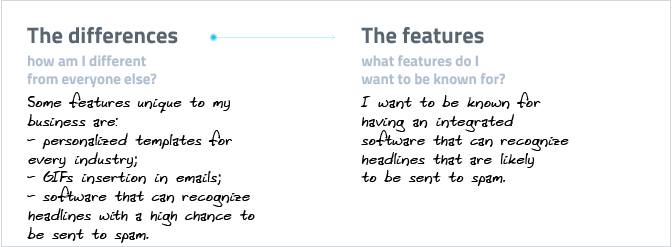
g. Write down your Unique Selling Proposition
Now, it’s actually time to write the Unique Selling Proposition statement. There’s no standard way to do it. It should be easy to read, understand, and appreciate.
In our canvas, we included a USP canvas for writing a simple and easy-to-remember statement. A one-size-fits-all, you could say. You can either use it as it is or as a starting point.
We at [Business name] help you
[resolve the consumer’s need]
by/with only/without [unique benefit].
Here’s the USP Canvas example:
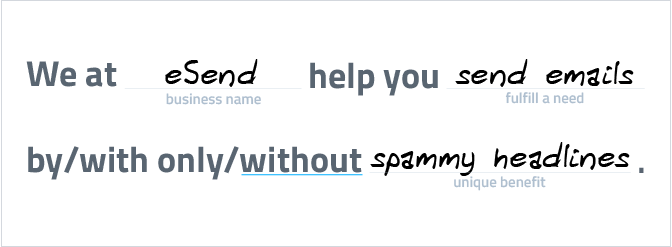
h. Make sure your Unique Selling Proposition is actually UNIQUE
Now that you have found the one-of-a-kind benefit you’re going to share with the world and you’ve put it in a statement form let’s give it a final check to ensure your USP statement will be a success.
We have thought of the UNIQUE checklist because, first of all, it’s easy to remember, and, second of all, because a unique selling proposition doesn’t mean different from competitors, but a lot more.
Your USP should be:
- Useful
The unique selling point needs to offer your target audience a unique benefit they’re actually looking for.
- Noteworthy
The USP statement should also be memorable so that when potential clients see your logo, they can say, “Oh, yeah, the company that does that thing.”
- Interesting
As we said at the beginning of this article, people see literally thousands of pieces of brand communication every day – so your USP has to be an attention stealer.
- Quantifiable
This is a very important aspect that we haven’t touched on much in this article. The benefit should be easy to measure so that the customer can appreciate its value. Also, if someone is not convinced about how true the statement is, having a quantifiable USP will help you deliver proof (statistics, examples etc).
- Understandable
When you’re a pro in your industry, you can get lost in the jargon. But when you’re writing the unique selling point, you should think about your customer reading it. If he/she doesn’t know the jargon, then you shouldn’t use it.
We talk about the voice you should use in the first article from the Less is more digital marketing methodology. You can check out the Buyer Persona article if you want to find out more. - Engaging
Lastly, but maybe most importantly, your USP should make customers want to contact you and to buy your product/service.
Once you’ve checked all the boxes, you’ve got yourself a unique selling proposition statement. Hooray!
Here is what that section looks like in our example:
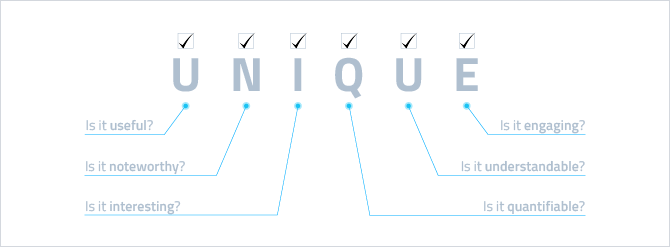
And here is the whole example of the USP canvas:
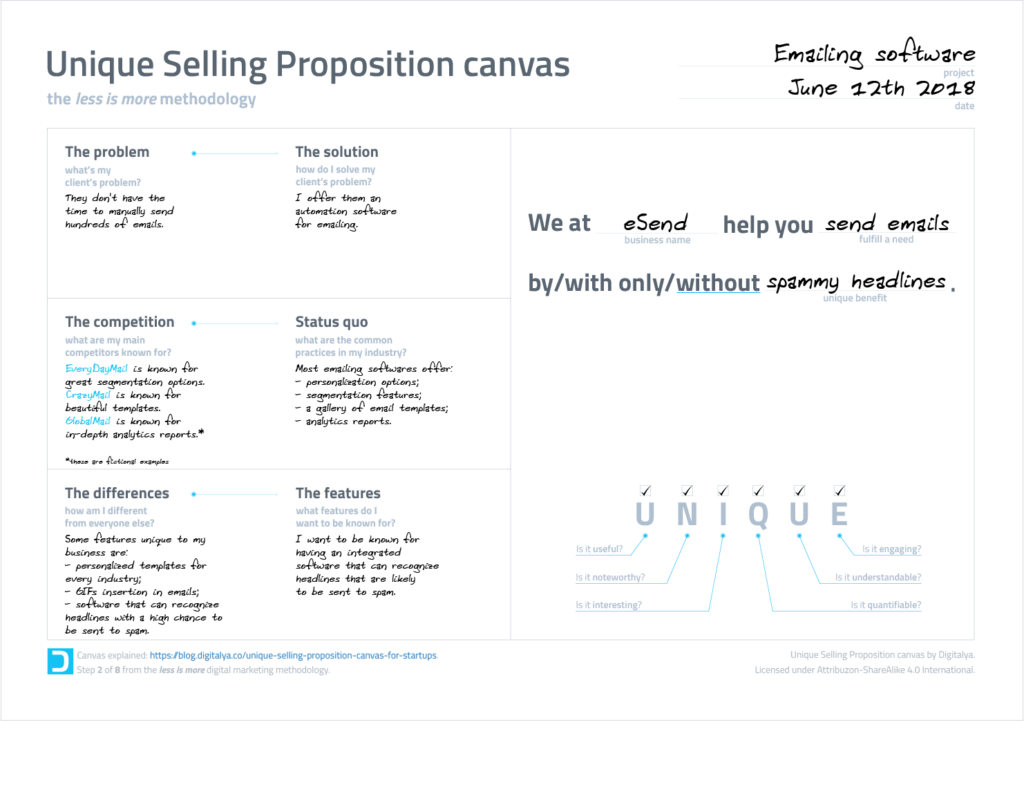
If you need inspiration, download the example above.
5. USP Canvas
We hope this article helped you not only to understand the importance of knowing your USP, but also to get a clear image with the unique selling proposition examples provided of how other brands are using it. We also hope that this resource helped you figure out how to write a unique selling proposition on your own.
Don’t forget to download our free USP canvas that helps you easily formulate a memorable USP statement.








